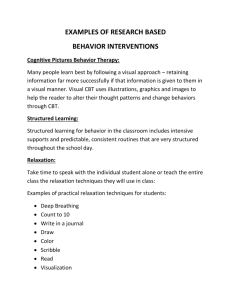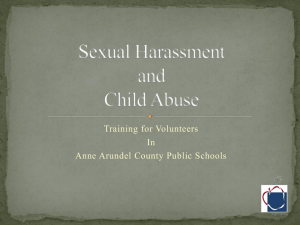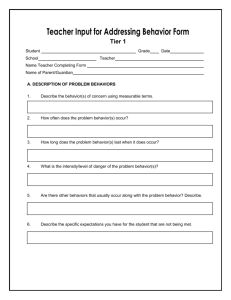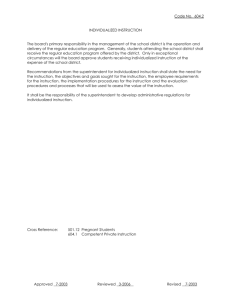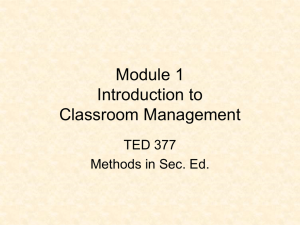Developing An Individualized Behavior Management Plan
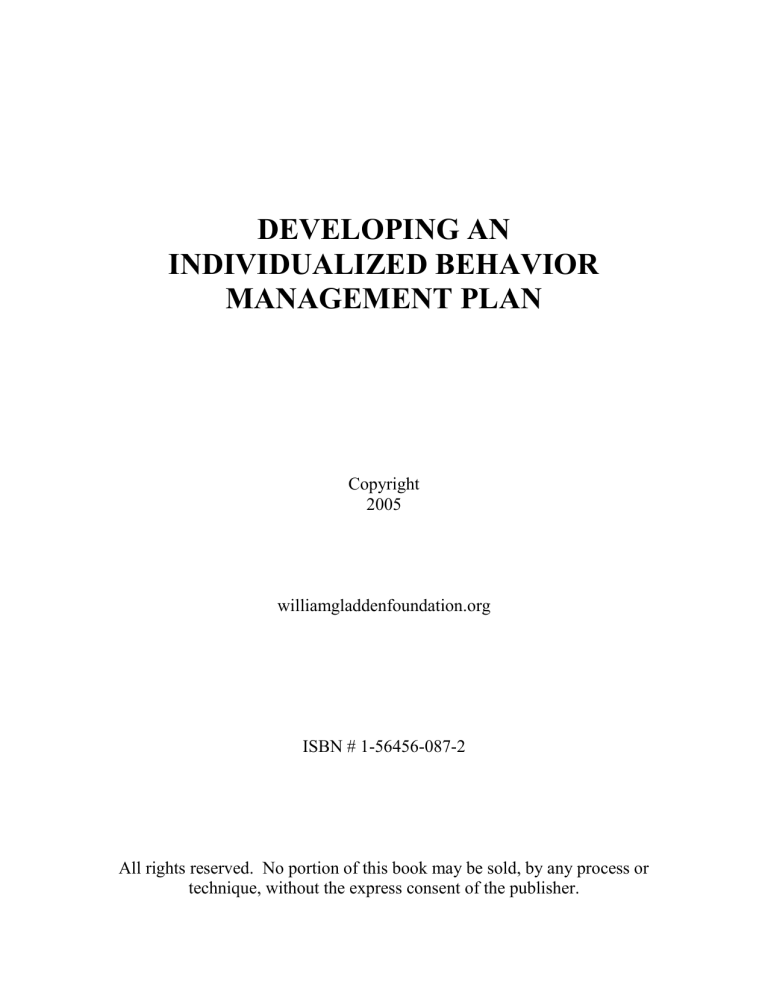
DEVELOPING AN
INDIVIDUALIZED BEHAVIOR
MANAGEMENT PLAN
Copyright
2005 williamgladdenfoundation.org
ISBN # 1-56456-087-2
All rights reserved. No portion of this book may be sold, by any process or technique, without the express consent of the publisher.
INTRODUCTION
Students are expected to follow classroom rules and to respect the rights of others.
However, not all students will comply with these expectations nor will they accept responsibility for their actions. Such circumstances may make it necessary to determine the cause for their misbehavior and the reinforcers or consequences with the strength to motivate behavior change. Upon determining these factors, it is possible to develop an individualized behavior management plan.
Misbehavior occurs for many reasons. Some students simply choose to disregard the rules and the rights of others and to reject responsibility for their actions. Other students are unable to behave properly because they lack the prosocial skills necessary to function appropriately with peers and adults. Whatever the cause of the misbehavior, interventions may be necessary so that they can achieve success, both behaviorally and academically, within their current educational placement.
Interventions may be as simple as having a discussion with the student about changing the inappropriate behavior, moving the student’s seat or adapting the curriculum.
However, after exhausting the traditional methods for managing behavior, it may be necessary to use a more structured approach to analyze the behavior problem. This is accomplished by an individualized behavior management plan.
There are four components in developing an individualized behavior management plan:
1) identifying what behavior is desired of the student, 2) determining what will motivate the student to exhibit the desired behavior, 3) establishing consequences to reinforce appropriate and inappropriate student behaviors and 4) identifying adults to participate in the development and implementation of the plan.
-II-
This publication provides administrators, teachers and instructional assistants with a systematic process for developing an individualized behavior management plan. The techniques suggested herein are derived from behavioral and cognitive approaches to managing children’s behavior in both the regular and special education classrooms.
Kathleen A. Riley, M.Ed.
Mary Lou Rush, Ph.D.
Robert L. Schwartz, Ed.S.
William Gladden Foundation
-III-
TABLE OF CONTENTS
QUESTIONS AND ANSWERS
What Is The Justification For Treating A Student With Inappropriate Behaviors
In A Manner Different From The Established Classroom Management Plan?..............5
How Do Teachers Find The Time To Develop And Implement An
Individualized Behavior Management Plan?..................................................................5
Why Should Teachers Put An Individualized Behavior Management Plan
In Writing?......................................................................................................................5
What Must One Do To Change Behavior?..........................................................................5
How Does One Identify The Behavior To Be Changed?....................................................6
What Is The Best Way To Describe The Target Behavior?................................................6
What Is The Importance Of Baseline Documentation?.......................................................6
What Method Of Documentation Is Best When There Are
30 Other Students Within The Classroom?....................................................................6
How Is The Cause Of The Inappropriate Behavior Determined?.......................................7
Once One Has Identified A Target Behavior, How Does One Initiate A Behavior Plan?..7
Once One Has Identified The Antecedents And The Target Behavior,
How Does One Write The Behavior Management Plan?...............................................7
How Does One Devise The Intervention Strategies?..........................................................7
How Does One Select Reinforcers?.....................................................................................8
Should Consequences Be Positive Or Negative?.................................................................8
How Does One Prevent Additional Inappropriate Behaviors?............................................8
How Does One Teach Appropriate Behavior?....................................................................8
How Does One Generalize And Maintain The New Appropriate Behavior?......................9
What Should One Do If A Behavior Plan Seems Unsuccessful?........................................9
How Long Should One Continue To Implement The Plan Before Giving It Up?..............9
What If Nothing Works?......................................................................................................9
DEVELOPING AN INDIVIDUALIZED BEHAVIOR MANAGEMENT PLAN
…10
SAMPLE INDIVIDUALIZED BEHAVIOR MANAGEMENT PLAN
….………....12
METHODS OF RECORDING BEHAVIOR
………..………………..…………..…..14
METHODS OF SELECTING REINFORCERS
…………………………..................15
CLASSROOM REINFORCERS TO ASSIST WITH INDIVIDUALIZATION …...16
SOURCES OF HELP AND INFORMATION
ABOUT STUDENT BEHAVIOR MANAGEMENT ……………………………..17
-IV-
WHAT IS THE JUSTIFICATION FOR TREATING A STUDENT WITH
INAPPROPRIATE BEHAVIORS IN A MANNER DIFFERENT FROM THE
ESTABLISHED CLASSROOM MANAGEMENT PLAN?
Classroom teachers must realize that not all students respond intrinsically to good grades, awards or positive comments. When students can’t or don’t function within the established classroom management plan, teachers are responsible for determining the cause of the misbehavior and developing an individualized behavior management plan.
HOW CAN TEACHERS FIND THE TIME TO DEVELOP AND IMPLEMENT
AN INDIVIDUALIZED BEHAVIOR MANAGEMENT PLAN?
Effective teachers don’t “find” time, they “make” time; that is, if they value classroom stability – and their own sanity. The sooner the teacher implements behavioral interventions, the less time will be lost during class dealing with inappropriate behaviors.
By not allowing misbehaviors to escalate, the result will be a teacher who can teach and students who can learn without interruption. There is much wisdom to the adage “An ounce of prevention is worth a pound of cure.”
WHY SHOULD TEACHERS PUT AN INDIVIDUALIZED BEHAVIOR
MANAGEMENT PLAN IN WRITING?
Written rules, responsibilities, procedures and consequences benefit everyone involved in the development of systematic classroom instruction. Instructional personnel benefit because they can deal with the student quickly, fairly and consistently. The student benefits because behavioral expectations are clear and concise, and he/she can make informed choices whether to respond appropriately.
WHAT MUST ONE DO TO CHANGE BEHAVIOR?
A child’s behavior will not change without impetus. To alter the behavior, adults need to change the methods in which they interact with the child and manipulate the environment
(i.e., classroom structure or academic expectations) to reinforce the desired behavior change. The term for changes implemented by the adults is “behavioral interventions,” and changes in the child’s behavior are the “response” to the adult interventions.
Therefore, both the adults’ and child’s behaviors must change if long-term behavior change is to be achieved.
-5-
HOW DOES ONE IDENTIFY THE BEHAVIOR TO BE CHANGED?
The first step is to identify a behavior that is having an adverse affect on the child’s social and academic performance. This is termed the “target behavior.” If the target behavior is one that irritates only you, ignore it. Describe the target behavior so that it is observable, measurable and repeatable (i.e., talking out in class or not completing written assignments).
WHAT IS THE BEST WAY TO DESCRIBE THE TARGET BEHAVIOR?
Concentrate on only one target behavior at a time. Identify the target behavior in specific terms (i.e., not completing written assignments). A specific definition of the target behavior will make it possible to evaluate the effectiveness of any and all interventions and will encourage consistency in interventions where several adults are attempting to change the behavior. Additionally, be equally specific in defining the desired appropriate behavior that is to replace the target behavior.
WHAT IS THE IMPORTANCE OF BASELINE DOCUMENTATION?
Baseline information provides the data necessary to make an accurate comparison of the frequency, intensity or duration of the target behavior both prior to and following the implementation of an individualized behavioral plan. It serves both as a “jumping off” point for establishing criteria for daily success and measuring of the overall effectiveness of the individualized behavioral management plan.
WHAT METHOD OF DOCUMENTING IS BEST WHEN THERE ARE 30
OTHER STUDENTS WITHIN THE CLASSROOM?
As the primary observers within their classroom, teachers need to choose methods for documentation depending upon the behaviors of concern. Different methods of documentation can be used when monitoring the following types of target behaviors: 1) not completing work, picking the nose and talking out (frequency); 2) sleeping in class
(duration); 3) exhibiting infrequent physical outbursts (anecdotal); and 4) writing down all the behaviors of concern in order to identify the target behavior (continuous recording).
-6-
HOW IS THE CAUSE OF THE INAPPROPRIATE BEHAVIOR DETERMINED?
Evaluate documentation to determine the antecedent (cause) of the inappropriate behavior. Determining the cause of the inappropriate behavior will increase the probability that the intervention strategy will be successful. For example, documentation may show that the student becomes verbally aggressive each time he has a difficult math assignment (antecedent). Documentation should answer the question: What is the misbehavior telling me?
ONCE ONE HAS IDENTIFIED A TARGET BEHAVIOR, HOW DOES ONE
INITIATE A BEHAVIOR PLAN?
Review the student’s records, interview his/her parents and consult with previous teachers and school personnel to determine the success or failure of past interventions.
Examine the school district and individual building discipline codes to determine the parameters for establishing rules and consequences for student behavior. There is an abundance of literature available in both textbooks and journals to research information that can help in selecting the best behavioral management strategy to match your teaching style.
ONCE ONE HAS INDENTIFIED THE ANTECEDENTS AND THE TARGET
BEHAVIOR, HOW DOES ONE WRITE THE BEHAVIOR MANAGEMENT
PLAN?
Define the desired appropriate behavior to replace the inappropriate one, or find an incompatible positive behavior to increase. Incompatible behaviors are those behaviors that cannot be engaged in simultaneously. For example, in-seat behavior is incompatible with out-of-seat behavior because a child cannot be both in his seat and out of it at the same time. The management plan must contain goals and objectives that reflect the behavior(s) to be increased.
HOW DOES ONE DEVISE THE INTERVENTION STRATEGIES?
Once the target behavior is identified, goals and objectives are developed and written to reflect the desired behavioral outcome. Develop behavioral strategies to implement the goals and objectives. Criteria for success, procedures for monitoring/documenting the behavior (i.e., point sheets, sticker charts), reinforcers and consequences are established.
-7-
HOW DOES ONE SELECT REINFORCERS?
“Different strokes for different folks!” Not all students respond to stickers and verbal praise. In developing a behavior plan, remember to provide positive reinforcers for engaging in appropriate behavior. Assist the student in developing a “menu” of tangible rewards, activities and responsibilities that are reinforcing and will help motivate the student to exhibit appropriate behavior. Observing the student while she is engaged in unstructured activities can provide insight into activities that are reinforcing. Questioning parents and previous teachers also may serve as sources for possible reinforcers.
SHOULD CONSEQUENCES BE POSITIVE OR NEGATIVE?
Consequences that occur immediately following misbehavior can be powerful in maintaining that particular behavior and may be positive or negative. The factor that determines whether the consequence is positive or negative is the meaning that it has for the student. For example, too often teachers catch students being “bad” and make an issue of it. If a student who misbehaved wanted attention, the teacher has increased the probability that the “bad” behavior will occur again. Teachers should deal in increasing appropriate behaviors and providing positive consequences, unless otherwise directed by their principal or supervisor. The rule “Catch them being good” is an important one.
Before attempting to decrease an inappropriate behavior by applying negative consequences, document the behavior in advance, establish the specific negative consequences and obtain parental consent in writing. Again, make sure consequences comply with building and district disciplinary policies.
HOW DOES ONE PREVENT ADDITIONAL INAPPROPRIATE BEHAVIORS?
Throughout the implementation of the individualized behavior management plan, the teacher not only needs to observe the target behavior but also must be “on the lookout” for other inappropriate behaviors interfering with academic, social and behavioral progress that may surface from decreasing/ceasing the target behavior. Continuous observation and documentation of the child’s behaviors during the implementation stage of the behavior plan will provide information to determine if this is occurring. If so, immediately develop an intervention that addresses the new behavior so that it will not escalate and become a habit.
HOW DOES ONE TEACH APPROPRIATE BEHAVIOR?
Teach appropriate behavior (prosocial skills) as a subject area, like reading, math and spelling. The teacher is responsible for writing lesson plans that reflect the goals and objectives developed in the behavior management plan. The lesson plans, along with documentation, are supporting evidence that behavior and other educational deficits are being addressed in the classroom. The behavioral skills must then be broken into sequential steps through task analysis, taught in context, practiced and reviewed frequently until mastered.
-8-
HOW DOES ONE GENERALIZE AND MAINTAIN THE NEW APPROPRIATE
BEHAVIOR?
The ultimate goal of a behavior management plan is to motivate a student to learn and maintain the appropriate behavior in all settings. Once the student consistently exhibits the appropriate behavior over time, consider withdrawing the reinforcer to determine if the student is capable of maintaining the desired behavior without it. However, if the external reinforcer is withdrawn too quickly, there is a high probability that the inappropriate behavior will return. Therefore withdraw the reinforcer slowly and cautiously, and then reevaluate the process periodically to maintain the desired behavior change. Once the child exhibits the behavior without artificial reinforcers in different settings, the individualized behavior management plan is successful.
WHAT SHOULD ONE DO IF A BEHAVIOR PLAN SEEMS UNSUCCESSFUL?
All behavior management plans are susceptible to response cycles before the desired behavior consistently replaces the target behavior. Expect routine setbacks. Often, the desired behavior can deteriorate or the undesired behavior can escalate or resurface, before improvement is noted. Thus, perseverance throughout implementation is a necessity.
HOW LONG SHOULD ONE CONTINUE TO IMPLEMENT THE PLAN
BEFORE GIVING IT UP?
Changing behavior takes time. Success of the plan not only involves following through with what is written on paper, but also includes teacher consistency, student reactions, support from home and numerous other factors. Events that are out of your control, such as home life and peer relationships, have the potential to create setbacks that undermine the plan’s success. Therefore, a behavioral plan cannot be properly evaluated until it has been given adequate time for all parties to react to the change. A minimum of four weeks, with weekly monitoring and making minor modifications, should elapse before implementing a different strategy.
WHAT IF NOTHING WORKS?
Information about negative, aversive or punishing stimulation is purposely not included herein. While these techniques may be effective, the potentially dangerous side effects may go undetected. Furthermore, the current trend toward litigation discourages the use of these techniques. Therefore, if you have exhausted all positive measures and the student has not responded appropriately, consider referring the matter to the building intervention assistance team, principal, supervisor or school psychologist.
-9-
DEVELOPING AN
INDIVIDUALIZED BEHAVIOR MANAGEMENT PLAN
As with any systematic plan, following the established procedures is critical to success.
This flow chart is a sequential blueprint of the essential steps in addressing inappropriate behaviors and developing an individualized behavior management plan.
(PLACE DIAGRAM HERE)
IDENTIFY TARGET BEHAVIOR – The behavior that most affects the student or class is the target behavior. It is often the behavior affecting social and academic performance. This is the behavior to identify, modify or change. The observer should document the student’s behaviors to determine which ones are interfering with him socially and academically.
NEGATIVE SOCIALIZATION AFFECTING ACADEMICS – Behaviors such as talking out or throwing spitballs during instruction create immediate distractions that impede academic progress. Behaviors like picking the nose or teasing may not immediately influence academics, but peer reactions can produce an emotional impact that eventually hinders academic performance.
ANNOYING, BUT HARMLESS – These behaviors may be bothersome but have no adverse affect on the learning process. For example, gum chewing or foot tapping.
Developing a behavior management plan for these behaviors may be futile because the child may escalate them just to be annoying.
-10-
IGNORE – The approach used to extinguish attention-getting and annoying, but harmless, behaviors. Often, when ignored, the behavior will briefly escalate in an attempt to get attention, but if the ignoring continues, it will cease. If, however, the behavior threatens people or property, take immediate action and develop an individualized behavior management plan.
COLLECT BASELINE DATA – The process by which a teacher or observer selects the appropriate method of documentation and begins to record the student’s behavior.
IDENTIFY PARTICIPANTS – Select the adults who will participate in the consistent implementation, modification and monitoring of the interventions.
ESTABLISH CRITERIA – After the target behavior is determined, analyze the baseline data to determine the percentage and/or number of times the student exhibits the target behavior. Using this information, establish a specific percentage and/or number of times the behavior can be exhibited and remain within the limits of acceptable behavior. For example, the student was inappropriately talking out 12 times during a 30-minute instructional period (baseline). The criteria established will be that during a 30-minute instruction period, the student will speak appropriately (i.e., when called upon by the teacher). The criterion for success is that the student may talk out inappropriately two or less times per 30-minute instructional period.
MONITOR WEEKLY, MODIFY IF NECESSARY – Continue documenting the target behavior throughout the intervention, reviewing the data weekly to determine its success or failure. Because behaviors usually get worse before improving, carefully watch the student’s reactions before modifying the behavior plan. Modifications include increasing, decreasing or changing the reinforcer, and modifying the criteria for success.
SUMMARIZE INTERVENTION – Once implemented for adequate length of time (at least four weeks), examine and review all data to determine the success of the intervention.
IF SUCCESSFUL (and the behaviors are being generalized and maintained, begin to withdraw the reinforcer) – The goal of an individualized behavior management plan is to have the student generalize and maintain appropriate behavior without external reinforcers. Monitor withdrawal of reinforcers carefully so that the target behavior does not recur in order to gain the reinforcer. Continue documenting throughout this transitional period. Increase and decrease the reinforcers as necessary until the appropriate behavior is generalized.
IF UNSUCCESSFUL (refer the problem to the principal, supervisor, psychologist or
IAT for further assistance) – If this systematic plan and modifications prove unsuccessful, seek assistance from professionals not directly involved with the child’s individualized behavior management plan.
-11-
SAMPLE
INDIVIDUALIZED BEHAVIOR MANAGEMENT PLAN
This sample individualized behavior management plan follows the steps identified in the flow chart and can modified to meet specific needs. Give special attention to 1) the types of reinforcers used and 2) the schedule of reinforcement. These are the keys to success!
STUDENT – Jeffrey D., a 4 th
grade student in Ms. Jones’s general education class, has constantly disrupted class throughout the first two months of school during teacher directed instruction. Through five 30-minute periods of continuous recording by the behavioral consultant, inappropriate talking was identified as the target behavior. Ms.
Jones reports that Jeffrey does not respond to traditional behavioral and curriculum modifications and reinforcements.
TARGET BEHAVIOR – Inappropriate talking out in class during teacher directed instruction and independent work (negative socialization activity affecting academics).
BASELINE DATA – Jeffrey was observed inappropriately talking out 33 times per half day. A frequency count determined baseline data for each time he engaged in appropriate talking out, separated by 30 seconds of silence.
GOAL – Jeffrey will speak only when called upon by Ms. Jones during teacher directed instruction.
PARTICIPANTS – Ms. Jones, special area (art, music and physical education) teachers, the building principal, behavior consultant and intervention assistance team. (A copy of this plan needs to be included in the substitute folder so that he/she can be consistent in dealing with Jeffrey).
CRITERIA FOR SUCCESS – If Jeffrey talks out inappropriately eight or less times per half day, he earns a star on a sticker chart.
REINFORCEMENT – Jeffrey was observed to enjoy playing math games on the computer. When asked what his favorite activities are in school, he responded, “Playing the computer.” He was asked if he wanted to earn computer time on a daily basis and he responded enthusiastically, “Yes.”
SCHEDULE OF REINFORCEMENT – For each “star” earned, Jeffrey may buy 10 minutes of computer time. Stars may be accumulated, but the length of computer time is not to exceed 30 minutes per day. Delivery of the reinforcer (computer time) will be offered between 2:30 and 3:30 daily. Additionally, Jeffrey may purchase the right to have a peer “work” with him on the computer at the cost of one star per 10 minutes.
-12-
MONITORING OF TARGET BEHAVIOR – Divide the day into two equal intervals of time. Each morning, issue Jeffrey nine paper clips linked together. Each time he exhibits the target behavior; Jeffrey will remove a paper clip from the chain, give it to
Ms. Jones and state the reason why he must surrender it. If Jeffrey has one or more paper clips remaining at the end of the morning interval, he will place a star on the sticker chart.
If there are no paper clips remaining, he will record an “X.” Repeat this procedure is in the afternoon. Jeffrey will carry the chain of clips to art, music, physical education and other special classes. All supervising adults will follow the same monitoring procedure.
MONITORING WITH THE HOME – Use green, yellow and red strips of paper to maintain daily contact with the parents. Two stars earn a green strip, one star a yellow strip and no star a red strip. Ms. Jones will date and initial the strips. Jeffrey’s parents will be encouraged to develop a schedule of reinforcements/consequences for the home, based upon the colored strip(s) he earned that day/week.
MONITOR WEEKLY, MODIFY IF NECESSARY – The plan will be monitored on a weekly basis with Ms. Jones. Upon review, if it is documented that Jeffrey is not meeting the established criteria (eight times or fewer per half-day interval), the number of paper clips will be increased by one or two daily until he achieves a threshold of success to earn the reinforcer. If Jeffrey is meeting the criteria at an 80% success rate or greater, the number of paper clips will be decreased at the rate of one per week until the appropriate behavior is generalized and maintained at an acceptable level without the use of paper clips.
SUMMARIZE THE INTERVENTION – If at the end of four weeks Jeffrey is responding to the intervention plan, it can be determined that the computer, praise and parent involvement have all contributed to the modification of Jeffrey’s negative socialization activity (inappropriate talking out in class during teacher directed instruction and independent work).
GENERALIZE AND MAINTAIN BEHAVIOR – Once Jeffrey is capable of maintaining the established criteria of the target behavior, gradually withdraw the number of paper clips and decrease the length of time and frequency of delivering the reinforcer
(computer time). Once the paper clips and computer time are no longer necessary, continue using praise and computer time intermittently to maintain the behavior.
IF SUCCESSFUL – Modify and make minor adjustments to the reinforcement schedule.
If nothing works after repeated modifications, refer the problem to the principal, supervisor, behavior consultant, intervention assistance team or school psychologist for help.
-13-
METHODS OF
RECORDING BEHAVIOR
Documenting baseline data can be difficult and time-consuming. The following methods assist in identifying most types of target behaviors. They can be modified to meet the needs of an individual student, the teacher’s style of teaching or the classroom environment.
CONTINUOUS RECORDING helps define the target behavior and understand its cause(s). The observer documents all events and categories of each behavior in terms of the antecedents, the behavior and the consequences.
FREQUENCY counts the number of times a behavior occurs within a specific period, and is appropriate for high frequency and discontinuous behaviors. There are two ways to do a frequency count. 1) Choose a specific time to observe the student. Schedule three or four 10 to 20 minute observation periods throughout the day. Make sure the length of time chosen is the same for each observation period. Tally each time the behavior occurs within the observation period. 2) Divide the observation period into equal intervals (i.e., 10 seconds, one minute, etc.). The length of the intervals is somewhat arbitrary, but, generally, the smaller the interval the greater the amount of information that can be obtained. An effective way to chart frequency is to put a “Post
‘em” in your teacher’s manual, and “strike tally” the behavior as it occurs while you continue to teach the lesson.
ANECODTAL RECORDING is used when the behavior is infrequent. The observer will need to record the antecedents, the behaviors and the consequences of each event.
To facilitate data collection, keep a log with each day of the week noted at the top. Each time the student exhibits an inappropriate or target behavior, note the time of the occurrence, the antecedent(s) and the consequence(s) of the behavior.
DURATION – determines the length of time a behavior does or does not occur. A stopwatch is the most reliable method for obtaining duration data. Set the observation for the time of day the behavior or non-behavior is likely to occur. Begin recording when the behavior/non-behavior first occurs and stop immediately upon its cessation. At the end of the observation period, tally the amount of time the student was engaged in the behavior. Establish the length of time each observation is to last (i.e., 30 minutes) and record during a specific time (i.e., 11:00 to 11:30) every day for at least one week.
-14-
METHODS OF
SELECTING REINFORCERS
Not everyone works for stars or good grades. Identifying reinforcers that meet a student’s specific desires/wants/needs is a skill, not a crapshoot. Remember, a reinforcer is what the child, not the teacher, finds reinforcing.
Observe the student throughout the school day to see what he does without your direction. Often, what he does is done at times you may deem inappropriate. For example, one student may choose to socialize with his friends during math; another student may look out the window at passing cars while you are lecturing; and another student may doodle on his work. These are all potential reinforcers that may differentially meet each student’s individual needs.
Teacher-made and commercially prepared scales and surveys also can help to determine appropriate reinforcers. For example, some rating scales and surveys provide general information about categories of reinforcers (i.e., adult attention, peer attention, escape, intrinsic, tangible, self-stimulation or sensory). Others help pinpoint specific reinforcers by directly asking students for information about their likes and dislikes.
Call the student’s parents or ask his/her previous teacher(s) to identify his/her likes and dislikes.
Directly ask the students what types of reinforcing activities he/she would like to have the opportunity to earn if he/she complies by exhibiting the desired behavior.
This is usually the easiest method.
For those students who do not respond to a consistent reinforcer, provide a menu
(written list, or pictures for the non-reader) of activities from which to select upon successfully meeting the established criteria.
Some students will find an unknown reinforcer exciting and will work for the opportunity to select from a “fish bowl” of mystery reinforcers. This method is especially successful because it is easily manipulated by providing powerful reinforcers for major behavioral changes and weaker reinforcers for minor ones.
Mixing powerful and weaker reinforcers so that the student receives intermittently powerful reinforcers is quite useful for modifying, generalizing and maintaining behaviors. A combination of both tangible and intangible reinforcer is highly recommended.
-15-
CLASSROOM REINFORCERS
TO ASSIST WITH INDIVIDUALIZATION
The most powerful force in changing behavior is the desire the student has to earn the reinforcer. The following is a list of tangible and intangible reinforcers that are a starting point when brainstorming ideas for a particular student. We recommend accompanying activity reinforcers with verbal and nonverbal reinforcement.
ACTIVITY REINFORCERS
Being a classroom helper
Being exempted from a test
Building a model
Decorating a bulletin board
Displaying work for the class to see
Earning a movie for the class
Earning a sticker
Going on a field trip
Listening to a story
Playing in the gym or on the playground
Reading a library book
Removing the lowest grade
Skipping a homework assignment
Working as a helper in the office
Working at the computer
VERBAL PRAISE
“Very good work.”
“Terrific!”
“You are really becoming a good student.”
“Keep up the good work.”
“I’m pleased with your work.”
“You really do that well.”
“I’m proud of you.”
“That’s the best job I’ve seen.”
GESTURES
Clapping
Smiling
Winking
Thumbs up
Nodding
-16-
SOURCES OF HELP AND INFORMATION
ABOUT STUDENT BEHAVIOR MANAGEMENT
Developing a successful individualized behavior management plan can be challenging, and collaborating with other professionals experienced in dealing with behavior problems can be helpful. The following list consists of individuals and agencies that can assist as resources in developing effective plans that comply with local, state and federal guidelines.
LOCAL SOURCES
PRINCIPAL/SUPERVISOR – Administrators of buildings or programs usually have contact with students who are exhibiting socially inappropriate behaviors. The administrators’ input regarding the constraints and guidelines of building or district policy is essential in the development of individual behavior plans. Their support is integral to the success of all plans.
SCHOOL PSYCHOLOGIST – Every school system either employs or contracts with licensed psychologists. They not only test student cognitive and achievement abilities, but also can provide insights about the child through behavioral and projective normreferenced tests.
BEHAVIORAL CONSULTANT – Many school boards employ individuals with a broad educational and experiential background in behavior management techniques and strategies. They can assist in all steps of the development of an individualized behavior management plan (i.e., forming observations to determine the target behavior to assisting with the weekly monitoring/modifications of the interventions).
INTERVENTION ASSISTANCE TEAM (also called “Building Level Teams) – The current trend in American education is for teachers to work in a collaborative effort for problem solving. Utilizing the expertise of experienced colleagues and staff familiar with a particular student’s problems enables the teacher to gain assistance at all steps of the plan development.
NATIONAL SOURCES
Family Education Network www.teachervision.fen.com
Pro Teacher www.proteacher.com
Behavior Advisor www.behavioradvisor.com
-17-

